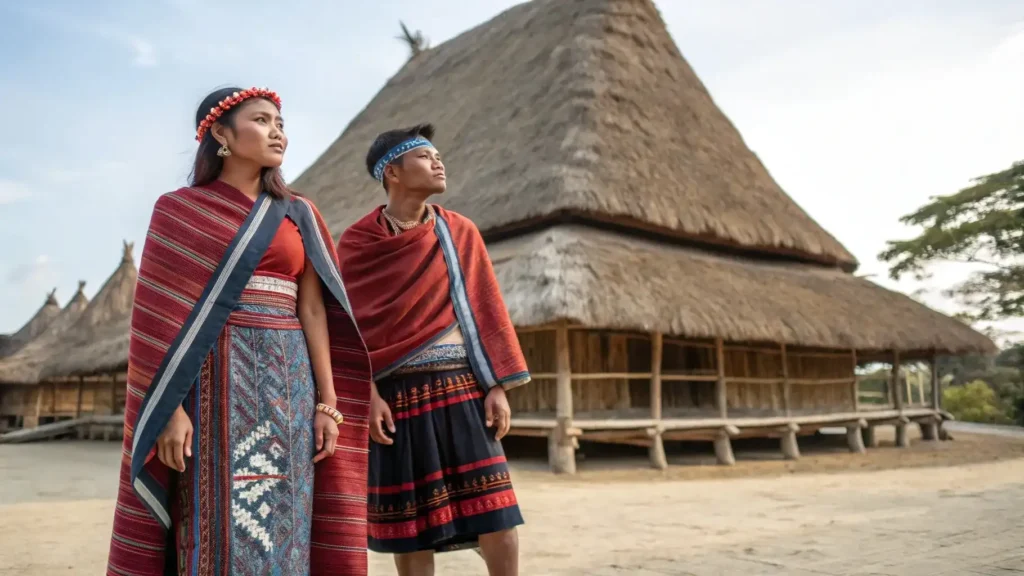Sumba Island in East Nusa Tenggara is well known for its stunning nature and unique cultural richness. One tradition that often catches public attention, both nationally and internationally, is the kawin tangkap culture in Sumba. This tradition has sparked both praise and criticism, as it is seen as part of ancestral customs, but also considered controversial for its implications on women’s rights and issues of modernity.
So, what exactly is kawin tangkap? Is it truly a form of violence against women, or is it a cultural practice that deserves to be preserved? Let’s explore it more deeply in this article.
Table of Contents
What Is the Kawin Tangkap Culture in Sumba?
In general, kawin tangkap refers to a marriage that begins with the capture or abduction of the bride-to-be by the groom’s party. In practice, a man will “capture” or run away with the woman he wishes to marry, taking her to his family’s house. Afterwards, customary negotiations and family discussions will follow to formally settle the marriage. This tradition is still found in several parts of Sumba, including Southwest Sumba Regency.
Although it may sound extreme, this tradition isn’t entirely spontaneous or without cultural reasoning. In Sumbanese culture, kawin tangkap often involves indirect communication or hidden agreements between the two families. There is usually a silent form of consent from the woman’s side, even though it may appear like a forced abduction on the surface. Still, this practice continues to spark controversy and debate regarding consent and women’s rights.
Socio-Cultural Background of Kawin Tangkap in Sumba
The tradition of kawin tangkap has existed for centuries within the indigenous communities of Sumba. In these communities, the social structure is strongly tied to a patriarchal system and kinship relations between clans, or kebisu. Men hold dominant roles in decision-making, including matters of marriage. Marriage is not merely seen as a union between two individuals, but also as a way to maintain family honor and social status. As a result, marriage decisions are often made by parents or tribal elders without directly involving the woman.
The motivation behind kawin tangkap can stem from a variety of social and economic factors. For example, if the woman’s family owes a debt to the man’s family, the daughter may be used as a form of “payment.” Other reasons include preserving ties between kebisu (clans) to prevent conflict or disconnection. Additionally, social pressures such as protecting the family name or maintaining one’s position in traditional society also play a role. In Sumbanese custom, once the “capture” happens, the woman’s family typically visits the man’s home to demand an appropriate bride price, or belis. This is then followed by formal customary rituals and a wedding according to local adat law.
Read more: Getting to Know the Marapu Tradition: Sumba’s Spiritual Heritage
The Kawin Tangkap Procedure in Sumba
One common method used in kawin tangkap is sending the woman to a public place, such as a market, to be “baited.” There, a group of men from the groom’s side are already waiting to abduct her. Usually, the woman will be dragged away, lifted onto a horse, and taken to the man’s house. She may scream, cry, and call for help.
However, the surrounding community does not react, as they understand it to be part of an agreed-upon traditional strategy. Afterwards, the woman’s family visits the man’s family to discuss the next steps, such as the belis (bride price) and the wedding date. According to a socio-cultural study (Kleden, 2017), kawin tangkap practices in Sumba are divided into two types:
1. Kawin Tangkap with Consent (Symbolic and Customary)
In this type, kawin tangkap is carried out with prior agreement between the man and the woman, as well as the full support of both extended families. The woman is already prepared, wearing suitable clothes and bringing household items like wardrobes, plates, buckets, spoons, and so on.
The abduction process is symbolic and treated as part of a cultural performance that is socially accepted. The main goal is usually to simplify the belis negotiations, as the “abduction” signals the seriousness of the man’s intention to marry.
2. Kawin Tangkap without Consent (Coercion and Violence)
This is the type that draws the most criticism. The woman is captured without her knowledge or agreement, often while doing routine activities like fetching water or going to the market. She is taken by force to be married to a man chosen by her family. Motivations for this type are often tied to:
- Family debts,
- Promises of arranged marriage,
- Strengthening kinship ties between kebisu.
In this practice, the woman has no other option but to surrender and follow her parents’ decision. This often results in severe psychological trauma.
The Difference Between Kawin Tangkap and Kidnapping
It is important to understand that not all kawin tangkap cases can be categorized as kidnapping in the criminal sense. In some instances, the woman who is “captured” has already agreed to the plan with the man. They may have been in a romantic relationship but lacked family approval due to economic, social, or customary reasons. Kawin tangkap then becomes a shortcut to marriage, even though it is still wrapped in a traditional scenario.
However, it’s undeniable that there are kawin tangkap cases carried out entirely without the woman’s consent. Some even involve physical violence, threats, and psychological pressure on the victim. These situations clearly violate human rights principles and go against gender equality values. This is what fuels fierce debates in today’s society, which is increasingly aware of the importance of protecting women’s rights.
Pros and Cons of the Kawin Tangkap Culture
The kawin tangkap culture in Sumba has triggered wide debates in modern society. Some view it as a tradition that must be preserved, while others consider it a violation of women’s rights. To understand the issue better, let’s explore both sides of this cultural practice.
Pros: Cultural Heritage and Symbol of Manhood
For many traditional communities in Sumba, kawin tangkap is seen as an ancestral legacy that must be protected. It is considered a symbol of a man’s bravery and responsibility toward the woman he wants to marry. The act of “capturing” is believed to reflect the man’s sincerity and determination to build a family. As long as it’s done with family consent and within the boundaries of customary norms, kawin tangkap is deemed respectable and legitimate.
Some parents even take pride when their son dares to carry out kawin tangkap as a sign of maturity. In this view, the tradition is not just about personal love, but also about family honor. There’s also a belief that kawin tangkap is a way to unite two large families, with the customary rituals that follow serving as formal legitimization. As long as the process follows adat and doesn’t harm either side, this tradition is seen as valid and honorable.
Cons: Violation of Women’s Rights and Cultural Irrelevance
However, from a human rights perspective, kawin tangkap is seen as a practice that harms women. It is often carried out without the woman’s clear consent and sometimes with coercion. Many victims of kawin tangkap suffer long-lasting psychological trauma and social pressure. This highlights serious violations of a woman’s right to determine her own life path.
In today’s modern world, this practice is increasingly viewed as irrelevant to the principles of gender equality and personal freedom. Women’s rights activists and the younger generation in Sumba are now vocal in opposing this tradition for the sake of protecting women’s dignity. Rejecting this practice does not mean rejecting culture, but rather advocating for a more just and humane tradition. That’s why many are calling for kawin tangkap to be reexamined and adjusted to align with human values.
Read more: Pasola Tradition in Sumba: A Meaningful and Fascinating Cultural War
Explore Sumba’s Culture and Nature with IndonesiaJuara Trip
The kawin tangkap culture in Sumba reflects how tradition and modernity often collide. On one hand, it represents ancestral heritage full of cultural values, but on the other, it raises critical questions about freedom and women’s rights. A balanced understanding is crucial so we can appreciate culture without overlooking human dignity. By fully understanding the traditional context, we can help encourage positive change while still honoring cultural roots.
If you’re curious about the authentic lifestyle of the Sumbanese people and their breathtaking natural surroundings, now is the perfect time to see it with your own eyes. With IndonesiaJuara Trip, you can explore traditional villages, witness cultural traditions, and enjoy Sumba’s untouched landscapes. It’s not just a holiday, it’s a meaningful journey to discover the local wisdom that continues to thrive today.
Join the Sumba Tour with IndonesiaJuara Trip and experience the captivating charm of its culture and nature firsthand!























